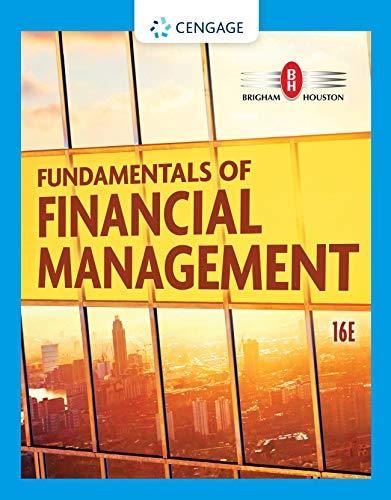In this chapter, we described how to estimate a companys WACC, which is the weighted average of
Question:
In this chapter, we described how to estimate a company’s WACC, which is the weighted average of its costs of debt, preferred stock, and common equity. Most of the data we need to do this can be found from various data sources on the Internet. Here we walk through the steps used to calculate Minnesota Mining & Manufacturing’s (MMM) WACC.
Questions 1. As a first step, we need to estimate what percentage of MMM’s capital comes from debt, preferred stock, and common equity. This information can be found on the firm’s latest annual balance sheet. (As of year end 2019, MMM had no preferred stock.) Total debt includes all interest-bearing debt and is the sum of short-term debt and long-term debt.
a. Recall that the weights used in the WACC are based on the company’s target capital structure. If we assume that the company wants to maintain the same mix of capital that it currently has on its balance sheet, what weights should you use to estimate the WACC for MMM?
b. Find MMM’s market capitalization, which is the market value of its common equity. Using the sum of its short-term debt and long-term debt from the balance sheet (we assume that the market value of its debt equals its book value) and its market capitalization, recalculate the firm’s debt and common equity weights to be used in the WACC equation. These weights are approximations of market-value weights.
Be sure not to include accruals in the debt calculation.
2. Once again we can use the CAPM to estimate MMM’s cost of equity. From the Internet, you can find a number of different sources for estimates of beta—select the measure that you think is best, and combine this with your estimates of the risk-free rate and the market risk premium to obtain an estimate of its cost of equity.
(See the Taking a Closer Look problem in Chapter 8 for more details.) What is your estimate for MMM’s cost of equity? Why might it not make much sense to use the DCF approach to estimate MMM’s cost of equity?
3. Next, we need to calculate MMM’s cost of debt. We can use different approaches to estimate it. One approach is to take the company’s interest expense and divide it by total debt (which is the sum of short-term debt and long-term debt). This approach only works if the historical cost of debt equals the yield to maturity in today’s market (i.e., if MMM’s outstanding bonds are trading at close to par). This approach may produce misleading estimates in years in which MMM issues a significant amount of new debt. For example, if a company issues a great deal of debt at the end of the year, the full amount of debt will appear on the year-end balance sheet, yet we still may not see a sharp increase in annual interest expense because the debt was outstanding for only a small portion of the entire year. When this situation occurs, the estimated cost of debt will likely understate the true cost of debt. Another approach is to try to find this number in the notes to the company’s annual report by accessing the company’s home page and its Investor Relations section. Finally, you can go to FINRA’s Bond Center (finra-markets.morningstar.com/BondCenter/) and do a quick search for MMM’s bond issues (3M CO). A longer-term issue’s YTM could provide an estimate of the firm’s current cost of debt to be used in the WACC calculation. Remember that you need the after-tax cost of debt to calculate a firm’s WACC, so you will need MMM’s tax rate (which is estimated to be 20%). What is your estimate of MMM’s after-tax cost of debt?
4.
a. What is your estimate of MMM’s WACC using the book-value weights calculated in question 1a?
b. What is your estimate of MMM’s WACC using the market-value weights calculated in question 1b?
c. Explain the difference between the two WACC estimates. Which estimate do you prefer? Explain your answer.
d. How confident are you in the estimate chosen in part c? Explain your answer.
Step by Step Answer:

Fundamentals Of Financial Management
ISBN: 9780357517574
16th Edition
Authors: Eugene F. Brigham, Joel F. Houston





